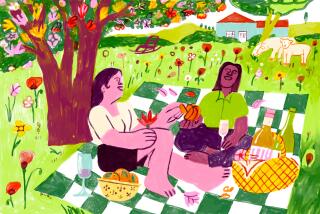Terroir-izing California wine
- Share via
So Alice Feiring, in her Op-Ed article, “California wine? Down the drain,” on the Golden State’s innovative and widely admired wine industry, thinks that “[d]ull, fruit-driven, alcoholic wines have become the incontrovertible wine identity of California.” I was immediately reminded of a line from Whit Stillman’s 1998 film, “The Last Days of Disco.” Young people are bantering on the topic of “yuppies” and whether that’s a desirable designation, when one of them says, “Young. Upwardly mobile. Professional. Those are good things, not bad things.”
California wine is the yuppie of global beverages and, at the moment, under assault from a cadre of wine writers, filmmakers and importers who have taken an ultra-conservative, borderline Luddite stance toward its incontrovertible dominance of the global wine business. (They are not, as they would like to be perceived, plucky independent thinkers who are bucking a mega-trend.)
Powerful fruit -- the product, for the most part, of extremely well-cultivated grapes, not technological manipulation -- is suspect. Alcohol, the result of the high levels of ripeness that California winemakers can achieve, is also a problem. Any whiff of technology in the winery, regardless of the magnificence of the product, needs to be indicted as if it were some unholy transgression against an ancient winemaking pact. Thou shalt not useth the demon oak. Beware the reverse-osmosis heresy. Pick not thy grapes when they art ripe, but rather pick them when they art green and unripe, the better to filleth thy wines with Old World structure and weird herby flavors.
It would be fine if this cabal kept to itself and sneeringly consumed its various backwater French bottlings -- for it’s essential that the competition be obscure, the better to support its “discovery” -- in grim silence. But, being members of a largely East Coast collective, they feel the need to capitalize on their proximity to both the major media and the “Old World” -- France, Italy, Spain -- by taking loud pot shots at California. Feiring of course makes no mention of the multitude of extraordinary wines from the state, many of which exhibit all the Old World complexity and balance anyone could ask for. She prefers instead to bang away at those that (allegedly) showcase too much ripeness, too much alcohol and, despite these alleged flaws, still cost too much.
For some time, Feiring and her cohorts have latched on to a singularly esoteric concept, taken from French wine lore: terroir, which basically refers to the way a wine reveals the place it came from. Terroir was first pitted against California wines when, after a brief hippie heyday in the 1970s when every winemaker was brewing up some scrumptious all-natural low-alcohol gem in a Silverado Trail shanty, California wine settled into a period of dreary brilliance, with it all tasting the same -- that is, wonderful. A dazzling sequence of great vintages, with wines based less on sense of place than quality in the bottle, represented a pretty decisive refutation of the terroir ideology. Bold cabernets and buttery Chardonnays trumped the pinched pencil-lead of first-growth Bordeaux and the ashen angularity of Grand Cru Burgundy.
When that gambit collapsed, the “terroirists” lambasted California -- which by this time had become the most successful winemaking region in the history of, well, wine -- for imposing a bland style on the rest of the world. America promotes democracy and market capitalism. California promotes wines that don’t suck. This cannot stand. The monumentally influential wine critic Robert M. Parker Jr. intensified the rage of the terroirists when he seemed to delight not in merciless, ironclad tannins and funky bacterial subtexts (which were probably due to cellar contamination) but the majesty of beautiful fruit.
The notion that a great wine could actually taste good right away and not 30 years later, once its general absence of ripeness had been replaced by strange flavors and odors, appealed to most consumers, so the terroirists needed to find a new stick with which to whack California. And being naturally fearful of technology in the hope they could restore the wine world to its Victorian-Communard Elysium, winemaker intervention became the new whipping boy. Pity the vintner who decided to mess around with what Mother Nature had given him. Quality in the bottle? Irrelevant!
This latest maneuver has morphed into a witch hunt, with the terroirists determined to nail any winemaker who embraces intervention, as if he were trying to defraud his customers. The struggling little vintner of France, with his allegiance to earth, sky and prelapsarian cellar, is now held up as the ideal, irrespective of the possibility that he would throw it all away for one lousy vintage that served up California-grade ripeness.
It’s pure gobbledygook. Anyone who has recently enjoyed a wine from Ridge, Au Bon Climat, Flora Springs, Joseph Phelps, Far Niente or literally hundreds of other California wineries knows that California wine is better than fine. And hey, if the terroir crowd wants to savor French wine and nothing else, no problem. Just don’t label California wine, something that pretty much everyone wants to drink, as “undrinkable.” I know the falling dollar has them running scared, as “overpriced” California wine is now a phenomenal bargain, but complete misrepresentation is better left to professionals. Like the long-dead and anonymous French marketing genius who, staring at a sea of swill, first muttered “terroir” and set this mad, dishonest joust in motion.
Matthew DeBord is a former editor at Wine Spectator and the author of “Wine Country USA.”
Blowback is an online forum for full-length responses to our articles, editorials and Op-Eds. Click here to read more about Blowback, or submit your own by e-mailing us at opinionla@latimes.com.
More to Read
A cure for the common opinion
Get thought-provoking perspectives with our weekly newsletter.
You may occasionally receive promotional content from the Los Angeles Times.






